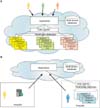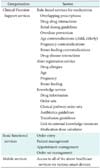1. Kanagaraj G, Sumathi AC. Proposal of an open-source cloud computing system for exchanging medical images of a hospital information system. In : Proceedings of 2011 3rd International Conference on Trendz in Information Sciences and Computing (TISC); 2011 Dec 8-9; Chennai, India. p. 144–149.
2. Padhy RP, Patra MR, Satapathy SC. Design and implementation of a cloud based rural healthcare information system model. Univers J Appl Comput Sci Technol. 2012; 2(1):149–157.
3. Yoon D, Chang BC, Kang SW, Bae H, Park RW. Adoption of electronic health records in Korean tertiary teaching and general hospitals. Int J Med Inform. 2012; 81(3):196–203.

4. He C, Jin X, Zhao Z, Xiang T. A cloud computing solution for hospital information system. In : Proceedings of 2010 IEEE International Conference on Intelligent Computing and Intelligent Systems (ICIS); 2010 Oct 29-31; Xiamen, China. p. 517–520.
5. Kagadis GC, Kloukinas C, Moore K, Philbin J, Papadimitroulas P, Alexakos C, et al. Cloud computing in medical imaging. Med Phys. 2013; 40(7):070901.

6. Kaushal DS, Khan Y. Cloud computing services in medical healthcare solutions. Int J Res. 2014; 1(4):312–324.
7. Kuo AM. Opportunities and challenges of cloud computing to improve health care services. J Med Internet Res. 2011; 13(3):e67.

13. Heiser J, Nicolett M. Assessing the security risks of cloud computing. . Stamford (CT): Gartner Inc.;2008.
14. Could Security Alliance. The Notorious nine: cloud computing top threats in 2013. [place unknown]: Cloud Security Alliance;2013.
15. Catteddu D, Hogben G. Cloud computing: benefits, risks and recommendations for information security. Heraklion: European Network and Information Security Agency;2009.
16. Armbrust M, Fox A, Griffith R, Joseph AD, Katz RH, Konwinski A, et al. Above the clouds: a Berkeley view of cloud computing. Berkeley (CA): Department of Electrical Engineering and Computer Sciences, University of California at Berkeley;2009.
17. Karthikeyan N, Sukanesh R. Cloud based emergency health care information service in India. J Med Syst. 2012; 36(6):4031–4036.

18. Pandey S, Voorsluys W, Niu S, Khandoker A, Buyya R. An autonomic cloud environment for hosting ECG data analysis services. Future Gener Comput Syst. 2012; 28(1):147–154.

19. Hsieh JC, Hsu MW. A cloud computing based 12-lead ECG telemedicine service. BMC Med Inform Decis Mak. 2012; 12:77.

20. Fong EM, Chung WY. Mobile cloud-computing-based healthcare service by noncontact ECG monitoring. Sensors (Basel). 2013; 13(12):16451–16473.

21. Hussain M, Khattak AM, Khan WA, Fatima I, Amin MB, Pervez Z, et al. Cloud-based smart CDSS for chronic diseases. Health Technol. 2013; 3(2):153–175.

22. Fernandez-Cardenosa G, de la Torre-Diez I, Lopez-Coronado M, Rodrigues JJ. Analysis of cloud-based solutions on EHRs systems in different scenarios. J Med Syst. 2012; 36(6):3777–3782.

23. Dixon BE, Simonaitis L, Goldberg HS, Paterno MD, Schaeffer M, Hongsermeier T, et al. A pilot study of distributed knowledge management and clinical decision support in the cloud. Artif Intell Med. 2013; 59(1):45–53.





 PDF
PDF ePub
ePub Citation
Citation Print
Print











 XML Download
XML Download